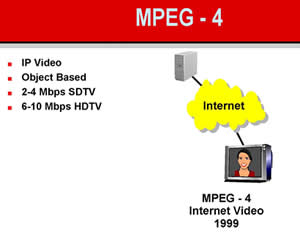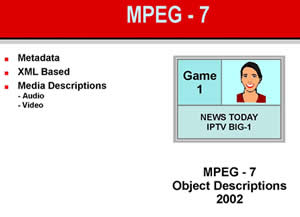Difference between MPEG4 and MPEG7
Key difference: MPEG stands for the Moving Picture Experts Group. MPEG4 was released in 1999 and was developed as an encoding method for devices with limited resources, mainly portable devices such as media players and mobile phones. This format is also often for online video and audio files, mainly streaming media, as well as for CD distribution, telephone, videophone and broadcast television applications. MPEG7 was released in 2002 and is a Multimedia content description standard. It is different that the previous formats, as unlike MPEG-1, MPEG-2 and MPEG-4, it does not deal with coding of moving pictures and audio. In fact, MPEG7 allows the embedding of metadata information into audio and video files.

MPEG stands for the Moving Picture Experts Group. It is a working group of experts that was formed in 1988 by ISO and IEC. It was a joint initiative between Hiroshi Yasuda of the Nippon Telegraph and Telephone and Leonardo Chiariglione. Chiariglione has served as the group’s Chair since the group’s inception.
The aim of MPEG was to set standards for audio and video compression and transmission. By 2005, the group has grown to include approximately 350 members per meeting from various industries, universities, and research institutions.
The standards as set by MPEG consist of different Parts. Each part covers a certain aspect of the whole specification. MPEG has standardized the following compression formats and ancillary standards:
- MPEG-1 (1993): Coding of moving pictures and associated audio for digital storage media at up to about 1.5 Mbit/s (ISO/IEC 11172). Designed to compress VHS-quality raw digital video and CD audio without excessive quality loss, making video CDs, digital cable/satellite TV and digital audio broadcasting (DAB) possible. It includes the popular MPEG1 Audio Layer III (MP3) audio compression format.
- MPEG-2 (1995): Generic coding of moving pictures and associated audio information (ISO/IEC 13818). Describes a combination of lossy video compression and lossy audio data compression methods, which permit storage and transmission of movies using currently available storage media and transmission bandwidth.
- MPEG-3: Dealt with standardizing scalable and multi-resolution compression and was intended for HDTV compression but was found to be redundant and was merged with MPEG2.
- MPEG-4 (1999): Coding of audio-visual objects. Includes compression of AV data for web (streaming media) and CD distribution, voice (telephone, videophone) and broadcast television applications. It includes the MPEG-4 Part 14 (MP4).
- MPEG-7 (2002): Multimedia content description interface. Not a standard which deals with the actual encoding of moving pictures and audio, like MPEG1, MPEG2 and MPEG4. It uses XML to store metadata, and can be attached to timecode in order to tag particular events, or synchronize lyrics to a song.
- MPEG-21 (2001): Multimedia framework. It is aimed at defining an open framework for multimedia applications. Based on definition of a Digital Item and users interacting with Digital Items.
MPEG4 was released in 1999 and was developed as an encoding method for devices with limited resources, mainly portable devices such as media players and mobile phones. This format is also often for online video and audio files, mainly streaming media, as well as for CD distribution, telephone, videophone and broadcast television applications.
MPEG4 is based on MPEG-1 and MPEG-2 standard and like them is a graphics and video lossy compression algorithm standard. However, MPEG-4 files are smaller in size and hence are preferred for streaming online or storing on portable players with limited disk space. This is mainly because MPEG-4 is based on wavelet technology that can compress color images at rates of 20:1 up to 300:1 and grayscale images at 20:1 to 50:1. Furthermore, the MPEG4 compression mechanism is a bit more complicated as compared to that of MPEG2. This is because MPEG4 needs better algorithms to scan and determine which pixels can be discarded, to reduce the data size even further.
Wikipedia lists the following as features of MPEG4:
- MPEG-4 enables different software and hardware developers to create multimedia objects possessing better abilities of adaptability and flexibility to improve the quality of such services and technologies as digital television, animation graphics, the World Wide Web and their extensions.
- Data network providers can use MPEG-4 for data transparency. With the help of standard procedures, MPEG-4 data can be interpreted and transformed into other signal types compatible with any available network.
- The MPEG-4 format provides end users with a wide range of interaction with various animated objects.
- Standardized Digital Rights Management signaling, otherwise known in the MPEG community as Intellectual Property Management and Protection (IPMP).
MPEG4 has gotten quite popular over the years. One of its most commonly used formats is the .mp4. MPEG-4 Part 12 was developed from the Apple’s MOV file and eventually resulted in MPEG-4 Part 14, which is the MP4 format. The MP4 is a container format. This means that it can be used to store audio and/or video data. MP4 video and audio can also be streamed over the internet.
 MPEG7 was released in 2002 and is a Multimedia content description standard. It is different that the previous formats, as unlike MPEG-1, MPEG-2 and MPEG-4, it does not deal with coding of moving pictures and audio. In fact, MPEG7 was designed to standardize: a set of description schemes and descriptors; a language to specify these schemes, called the Description Definition Language (DDL); and a scheme for coding the description.
MPEG7 was released in 2002 and is a Multimedia content description standard. It is different that the previous formats, as unlike MPEG-1, MPEG-2 and MPEG-4, it does not deal with coding of moving pictures and audio. In fact, MPEG7 was designed to standardize: a set of description schemes and descriptors; a language to specify these schemes, called the Description Definition Language (DDL); and a scheme for coding the description.
MPEG7 allows the embedding of metadata information into audio and video files. Hence, the audio and video files can be searched and indexed based on the information about the content instead of searching the actual content bitstream. MPEG7 does this by using XML to store the metadata. It can then be attached to timecode in order to tag particular events, or synchronize lyrics to a song. An advantage to using XML to store the metadata is that XML is universal. Hence, MPEG7 can be read my most existing tools that support XML parsing.
MPEG7 is not generally used today by the average user and adoption has been slow. However, Wikipedia lists the many applications and application domains that can benefit from the format, including:
- Digital library: Image/video catalogue, musical dictionary.
- Multimedia directory services: e.g. yellow pages.
- Broadcast media selection: Radio channel, TV channel.
- Multimedia editing: Personalized electronic news service, media authoring.
- Security services: Traffic control, production chains, etc.
- E-business: Searching process of products.
- Cultural services: Art-galleries, museums, etc.
- Educational applications.
- Biomedical applications.
MPEG4 and MPEG7 are often enough combined together to be used on a single audio/video file. The combination of MPEG-4 and MPEG-7 has been sometimes referred to as MPEG47. The ‘MPEG-47’ is described by MPEG as Tools for Killer Applications. This combination of the two standards is intended to be the ideal solution for efficient streaming of content, content manipulation and indexing of content.
Image Courtesy: althos.com









Add new comment